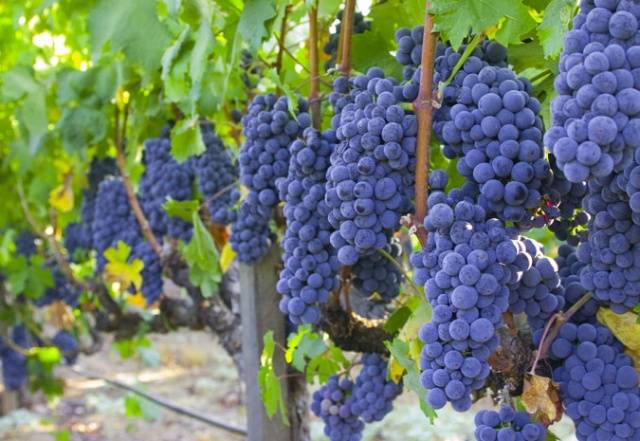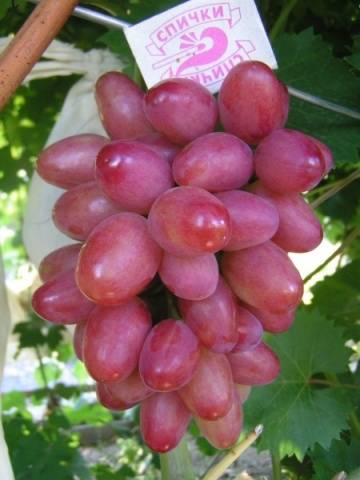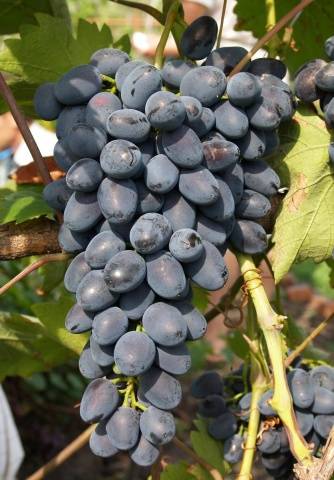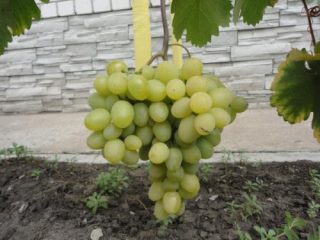Content
- 1 How to choose a grape variety
- 2 Description of grape varieties in alphabetical order
- 2.1 "Arcadia"
- 2.2 "Bazhena"
- 2.3 "Vanyusha"
- 2.4 "Harold"
- 2.5 "Demeter"
- 2.6 "Yesenin"
- 2.7 "Pearl of Saba"
- 2.8 "Fun"
- 2.9 "Isabel"
- 2.10 "Cardinal"
- 2.11 "Lydia"
- 2.12 "Moldova"
- 2.13 "Nina"
- 2.14 "Original"
- 2.15 "In Memory of Negrul"
- 2.16 "Rue"
- 2.17 "Sofia"
- 2.18 "Tason"
- 2.19 "Ukrainian"
- 2.20 "Favor"
- 2.21 "Charlie"
- 2.22 “Anniversary of the Kherson “Dachnik”
- 3 Conclusion
Before buying new grapes for your plot, you need to decide what this variety should be. After all, today there are many varieties of grapes, and each of them has its own characteristics: taste, appearance, resistance to cold or prolonged drought, height and branching of the vine, requirements for care and planting.
There are a lot of classifiers for grape varieties, but the most convenient is considered to be the one that divides grape varieties alphabetically. A description of the most popular of them can be found in this article.
How to choose a grape variety
Experienced winegrowers know many varieties of this plant, can identify the variety by the appearance of the vines and clusters, and talk about the preferences and requirements of a particular grape.
Those who are just starting out in viticulture should answer a few questions:
- For what purposes will the vine be grown?. After all, all varieties are divided into two large groups: table and industrial grapes. The first one is eaten fresh, its clusters are usually heavy, and the berries are large and tasty.Technical varieties are intended for processing; the berries contain a lot of sugars, which is very important in the production of wine or juice.
- What are the climatic conditions of the region and the composition of the soil on the site. Different varieties require a special climate, because there are frost-resistant varieties and grapes that can only grow at above-zero temperatures. In such cases, the vine will have to be covered for the winter and pruned in a special way. Regarding the composition of the soil, everything is simpler: you can always replace the soil or enrich it with the necessary components.
- How quickly the vine forms and the shoots ripen. This factor directly determines when young grapes begin to bear fruit. This also includes the yield of a particular variety.
- Quality and taste of fruits - those indicators that are especially important for every winegrower.
Description of grape varieties in alphabetical order
Brief description and photo of each variety from the alphabetical classifier:
"Arcadia"
The grapes of this variety are distinguished by early ripening and are heat-loving, so it is recommended to plant such a vine in the southern regions of the country. It is a table variety and has large yellow-green berries. The yield is very high, and with good care it can reach record levels. The berries are moderately sweet, have a nutmeg flavor, and are suitable for making homemade wine. "Arcadia" needs careful care, moderate watering, and mineral-rich soil.
"Bazhena"
It is a table variety with elongated light berries of a fairly large size.The bunches ripen very quickly (in 3.5 months), the yields are high. Yellow grapes have a sweet, very pleasant taste. The pulp of the grapes is fleshy and moderately juicy. It is necessary to prune the vine correctly, leaving six eyes, water and fertilize the grapes regularly.
"Vanyusha"
Refers to hybrid table grapes. The bushes of this variety develop very rapidly, the ripening time of the clusters is average (harvest is usually in August). The yields are stable and very high. The berries are large, yellowish-white, with dense, juicy pulp. The vine needs to be pollinated, diseased and weak shoots cut out, regularly watered and fed at least twice a year.
"Harold"
It is considered one of the most unpretentious and very productive varieties. The grapes are suitable for growing in any climatic conditions; they are often chosen by winegrowers in the North. After the spring awakening, the clusters ripen in record time - in just 3 months. Due to high fertility, shoots often break off, so it is important to thin out the bunches to prevent overloading the vine. The grapes are large, greenish-white in color, with a delicate, slightly muscat flavor. The berries are quite sweet, have seeds, and are suitable for home winemaking. The vine needs to be tied up; during pruning, no more than twenty inflorescences should be left on the shoot.
"Demeter"
Most experienced winegrowers consider this variety to be the best of the best. The grapes are medium-early in terms of ripening - the berries ripen 3.5-4 months after the appearance of the first spring buds. The yield of the variety is average, the berries have a white or amber hue, the taste is sweet and natural.At the pruning stage, it is necessary to regulate the number of bunches, since Demeter vines often break off under the weight of ripe grapes.
"Yesenin"
This is the variety that will produce the first fruits already in the second year after planting. These grapes are table grapes, with average ripening periods. The peculiarity of the variety is that wasps do not eat it, so all the bunches have a marketable appearance. The harvest is plentiful, the berries are light in color with a pink undertone, large and sweet. The bush needs to be formed in such a way that it produces as many woody vines as possible, because most of the harvest ripens on them.
"Pearl of Saba"
It is a Hungarian table grape. The variety's fertility is average; harvests ripen in mid-August. The berries are small, round in shape and greenish-yellow in color. The taste is sweet, slightly nutmeg. The bunches should not be allowed to overripe, as this will greatly deteriorate the taste of the berries. The vine needs to be pruned short (to a maximum of eight buds); for the winter the vine needs shelter, since the variety does not tolerate cold well.
"Fun"
The same applies to table varieties. The grapes are distinguished by large clusters with beautiful round dark blue berries. Ripening dates are early, yield is high. There is a lot of sugar in grapes, the taste is very pleasant, the skin is thin. For this variety, it is important that the soil has good air permeability, so the soil is chosen to be loose, and the soil around the vine is regularly fluffed up with a hoe.
"Isabel"
A very common late ripening grape. The harvests are stable and quite abundant. Most ripe grapes have a strawberry flavor, but some sour berries can also be found in clusters. The shade of the fruit is almost dark blue black. There is enough sugar in the grapes, each berry is completely covered with a white coating, so “Isabella” is excellent for home winemaking. The variety can be planted in any region, the main thing is that the clusters have time to ripen. Morozov is not afraid, there is no need to cover him. They are fed rarely - with mineral components once every three years, with manure twice a year.
"Cardinal"
Came to Russia from America and is considered a table variety. A distinctive feature is tall and long vines. It can produce high yields, but they are unstable. The clusters ripen early - in 3.5 months. The grapes are round, dark purple in color, juicy, with a slight nutmeg flavor. It is recommended to grow the variety on southern slopes, as it loves warmth. Before winter, the vine needs to be covered. Due to the susceptibility of grapes to various diseases, they constantly need to be treated with special preparations for preventive purposes.
"Lydia"
It is one of the few universal varieties. The grapes are very productive and ripen at the end of summer. The grapes are round, light lilac or dark pink in color. They have a strawberry flavor and become tastier if they sit in their plucked form. The vine is not covered for the winter; it is recommended to treat it with Bordeaux mixture, carefully thin it out, and cut it long.
"Moldova"
Refers to late grape varieties, is considered a table variety, although the wine it produces is very tasty. Productivity is good. The berries are dark, round, fleshy, and the skin is crisp. It is better to plant the vine on the south side of the site; there is no need to cover it; it is recommended to water it regularly.
"Nina"
It belongs to the table species, has good yield, ripens within 3.5 months. The grapes are large, pink, with a slight sourness. The care required is very simple; in rich soils the vine grows intensively, so it needs to be tied up. “Nina” does not like neighbors, so it is better to plant it separately from other varieties.
"Original"
It grows quickly and very intensively and is considered a table species. Every year you can get a stable and fairly good harvest from the vine. Ripens in medium terms. The grapes are elongated, pink, have a normal taste and thin skin. “Original” should be watered regularly: at least once a month.
"In Memory of Negrul"
Very beautiful and delicious grapes table variety. Ripens quickly and produces good yields. The grapes ripen large, have an elongated shape and a dark blue color. The berries taste sweet and sour, aromatic, with seeds. In winter, the vine must be covered, as the grapes are afraid of severe frosts. You need to trim the vine so that there are about 40 buds left on one bush.
"Rue"
Refers to early ripening varieties for table use. The productivity, although not very high, is stable. The pink berries taste quite pleasant, sweet, with a hint of nutmeg. The soil for planting must be nutritious; it must be constantly loosened; it is recommended to mulch for better moisture retention.
"Sofia"
It is considered an early ripening table grape. For pollination, the vine needs a partner, for which the Arcadia variety is most suitable. Harvests are abundant and constant.The aroma of the berries is very delicate, with slight notes of nutmeg, the peel is thin, and the pulp is sweet. The vine is pruned to 4-6 buds, fertilized rarely with nitrogen, otherwise the bush will grow.
"Tason"
Appetizing table grapes with early ripening. The yield is high, clusters can even appear on the stepsons of the vine. The berries are very tasty and sweet, their flesh is crispy and juicy. It is unpretentious in planting, loves frequent watering and good drainage. To increase yields, you need to fertilize the bushes and pull out weeds near the vine.
"Ukrainian"
It is another table variety. The ripening speed is average, the yield is sufficient and stable. The taste of the berries is nutmeg, sweet - they are well suited for winemaking. The color of the grapes is dark pink, round in shape. The soil needs to be loosened regularly, the vines must be treated against pests, and fed frequently.
"Favor"
It is a mid-early grape and produces good yields. Pink berries are distinguished by their juiciness, pleasant taste, and moderate sweetness. The soil around the vine needs to be mulched, and the plant itself must be treated with magnesium sulfate once a year.
"Charlie"
Ripens early and yields consistently high yields. The clusters are large, the berries are medium-sized, dark blue. The taste is good, but the bunch must ripen on the vine. "Charlie" should be planted in a well-lit area, maintaining sufficient spacing between plants. The vine is fertilized every month; there is no need to cover it in winter.
“Anniversary of the Kherson “Dachnik”
Ripens quickly and pleases with stable yields. The grapes are elongated, large, pink. The taste is excellent, unique, sweet. The shoots need to be trimmed short to two to four buds.
Conclusion
All presented varieties deserve the attention of beginning winegrowers.All that remains is to compare your capabilities and the requirements of each variety in order to choose the most suitable grapes for your plot.

































